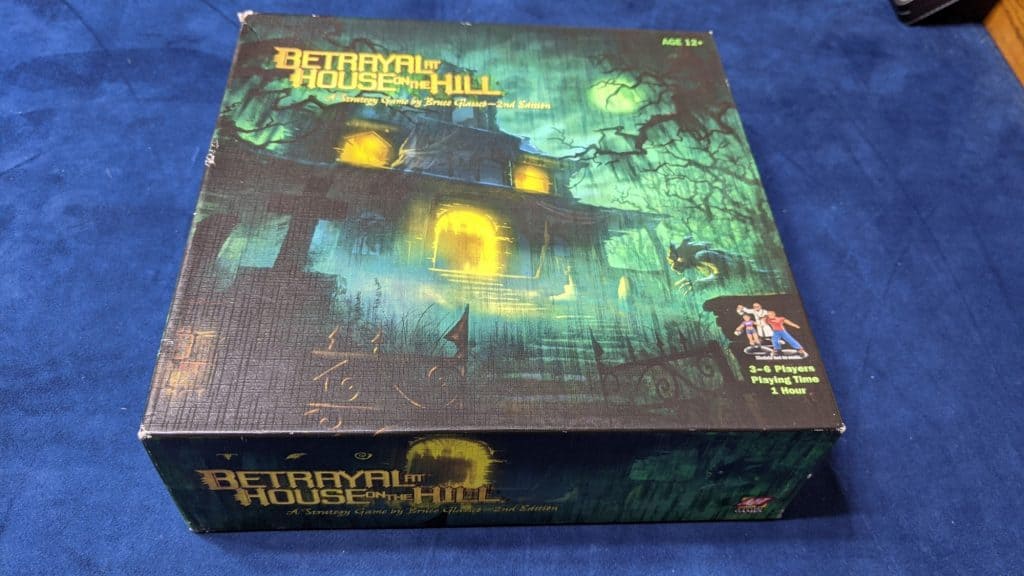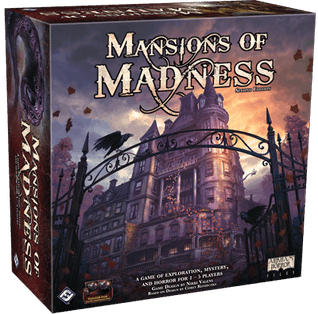There are certain games that stick out because they are so unique that they clearly belong to a very small, narrowly defined genre.
So Mansions of Madness Vs Betrayal at House on the Hill: which game is better?
Mansions of Madness is better for a thorough in-depth experience like a TTRPG and is especially good for roleplaying groups while Betrayal at House on the Hill is better for a more casual 60-90 minute co-op turned competitive horror board game experience.
While individuals who have played Betrayal at House on the Hill might bristle at the idea of that game being casual. Which is fair…at least until you compare it at the often 3 hour plus Mansions of Madness.
Both games are players racing against the horrors of a haunted house before it’s too late with Betrayal always ending up with a traitor as one player is supernaturally turned against the others, while with Mansions one player is the equivalent of a “game master” who is referred to as the Keeper and actively works against the players sometimes creating a traitor mechanic, sometimes not depending on the scenario.
What These Games Have in Common
- Haunted House Setting
- Co-op Group Vs. One Player Mechanics
- Very Atmospheric Settings
- Scenario Based Games
- Great Art on the Room Tiles
- A Story Is Told
How these games execute each point can be radically different, but that’s part of what makes comparing these games so interesting. While reading descriptions of both might make them seem very similar to a player who has never participated in a game of either, as someone who has thoroughly enjoyed both games, they give radically different playing experiences.
Which is part of what makes this comparison so interesting, necessary, and HARD.
They each provide a great gaming experience and I wouldn’t blame any board game enthusiast who wanted both of these games added to his/her collection. They are both outstanding options but this is a comparison post so it’s time to do the deep dive into each game, what each one does better than the other, and to give you the information to decide which game is the best for you – or which of these haunted house games you will purchase first before getting the other down the road.
Introducing Betrayal at House on the Hill
We’re no strangers to Betrayal at House on the Hill. It has hit the table many times. Supporting 3-6 players, Betrayal starts as a fully co-op game as players work to explore as much of the House as possible, find items, have supernatural experiences, and hopefully avoid the disaster of setting off the haunting too early.
Setting off the haunting is inevitable as eventually the dice roll required to stop it from happening will be too high to make. Depending on which room sets it off, the scenario is then picked from a book. One player then becomes turned by the supernatural influence of the house and at that point it’s the rest of the players versus the traitor.
Sometimes the emphasis is killing the traitor, sometimes it’s revealing certain rooms to set trapped spirits free, and sometimes it’s just to sprint to get the bleep out of the house before a limited number of turns passes while the traitor and his/her supernatural buddies try to murder you so you can stay there forever and ever and ever…
And anyway, back on point. Betrayal is a great atmospheric game with wonderful writing not only in the scenarios but on the Item and Omen cards, as well. Despite that excellent haunted house atmosphere, Betrayal creates a fun romp that feels light-hearted and fun as you race to explore, and then eventually fight or escape.
Rooms are revealed as they are drawn from a stack, creating a new map each time that can have a slew of items or a slew of omens – and this keeps the gameplay incredibly fresh.
The average game time is said to be 60 minutes although truthfully we find 90 to be more accurate when you look at setup and other similar considerations. Of course we’re a pretty casual group who stream, so that does add to the time and we have had terrible luck games that ended in just under 30 minutes.
What Betrayal at House on the Hill Does Better Than Mansions of Madness
- Faster game – 60 to 90 minutes is a enough to have a full fun experience
- Many more scenarios
- Better suspense because players don’t know what room they’re going to get next or what experience is in there
- Better for casual gamers
- Lower price point
- Doesn’t require a game master to run – which for some groups is going to mean more fun for everyone
- Provides a relatively mentally light gaming experience, so it doesn’t exhaust you from intense thinking
- Very high replay value
What Betrayal at House on the Hill Does Worse Than Mansions of Madness
- While the minis aren’t bad, they aren’t special – Mansions’ are actually quite amazing
- The card material is also better on Mansions
- There is a lot more luck involved as opposed to planned out strategy
- Shorter game, which can end abruptly, a definitely con if you were ready to settle in for the long haul
- Can’t provide the thorough in-depth story that Mansions is designed to provide

Introducing Mansions of Madness
Mansions of Madness is an in-depth scenario game that players of tabletop RPGs will be very familiar with. Named as game of the year by Geek & Sundry in 2016, unlike Betrayal, the house is fully laid out in the beginning so players know where the rooms are even if they don’t necessarily know what the scenario is or how situations might play out in each one.
Mansions of Madness does a great job delivering a Lovecraftian story with a guided game format that DnD and other role players will jump right into. It might take a bit of time for non TTRPG gamers to get into it, but the board game elements are there to help the adjustment and create a fantastic gaming experience for all involved.
In Mansions of Madness there is once again a house where supernatural occurrences are plaguing the local area. Unlike Betrayal where the house itself and its insidious energy is feeding/sapping off the players, in Mansions the location is made the way it is because of a scenario. This leads to investigation, direct danger and challenges from the beginning, and a pretty engaging storyline in its own sense.
These scenarios are well thought out with the players playing as a team while one player is on the side of the Mansion and the terrors behind it, although there are app tie ins to Steam for second edition that makes that optional so all players can go co-op.
It’s worth noting that although the base game only had four scenarios in original base game, multiple expansions have added many more scenarios that provide more than most gaming groups are likely to ever need especially considering these can be 3-4 hours a pop. This ups the replay value quite a bit, but the expansions must be bought, which is an issue for those gamers with a limited budget.
What Mansions of Madness Does Better Than Betrayal at House on the Hill
- The minis and quality of card stock and board are incredible
- The game is absolutely beautiful
- More in-depth story
- More strategy to play
- Provides a great long gaming experience (if time commitment isn’t an issue)
- No one is surprised to become a forced bad guy part way through (not a problem with our group but I know some gamers prefer staying co-op)
What Mansions of Madness Does Worse Than Betrayal at House on the Hill
- Far fewer scenarios, so less replay value after a certain point
- Higher price point, which is a concern on a limited budget when there’s a potentially limited replay value
- Won’t make rotation as often because of mental stress playing an intensive 3 hour thinking game can be quite heavy
- Less suspense since the map is laid out from the beginning

Gamers who love these games also tend to love: Battlestar Galactica (if you can find it), Descent, Arkham Horror, as well as DungeonQuest, HeroQuest, & RuneBound if you like D&D type themes or settings.
Betrayal At House On The Hill Vs Mansions Of Madness Verdict
Both of these haunted house games are amazing experiences even if you stay with the original game and don’t bother with any of the expansions, which both also have. The expansions work well for both games only further adding to the original base games so don’t hesitate to add them – but this article is about comparing the base games.
And let me get this out there right now: both games are fantastic. There’s a reason that both are considered absolute classics.
Personally, I think for most gaming groups Betrayal at House on the Hill is the better purchase if you can only buy one. The 60-90 minute playing time is less prohibitive, the game tends to have a fun and easy-going air that’s fun despite the suspenseful horror setting. There’s a place for both, but to me I’m almost always up for a game of Betrayal while I have to be in the mood for Mansions and at the end of the day that’s always a good rule of thumb tie breaker.
The exception is if your group of gamers are very serious intense gamers who go far more to the TTRPG side of things than board games in which case Mansions of Madness will get enough play with the group to possibly be worth the earlier pickup. You need a group willing to consistently dive into the intense experience in order to get the most out of it.
And when you do, the experience is worth it…but that is going to be much harder to find than a group willing to play another game of Betrayal.
As I said both of these Haunted House board games are excellent and should belong to any extensive gamer’s collection.
Get Your Copy Today!
Pictures linked to Amazon (affiliate) so you can see up to date pricing on these outstanding games.
Other Board Game Articles You May Love
- How to Win at Pandemic Board Game
- How to Play Dungeon Mayhem
- Best Co-Op Board Games
- Best Board Games Like Clue
- Settlement Placement Guide Catan

Proud to embrace the locally created moniker of “Corrupt Overlord” from one of the all time great Lords of Waterdeep runs, Shane is one member of the Assorted Meeples crew and will be hard at work creating awesome content for the website. He is a long-time player of board games, one time semi-professional poker player, and tends to run to the quirky or RPG side of things when it comes to playing video games. He loves tabletop roleplaying systems like Dungeons & Dragons, Pathfinder, Werewolf, Fate, and others, and not only has been a player but has run games as DM for years. You can find his other work in publications like Level Skip or Hobby Lark.


